2014 FIFA World Cup
| Copa do Mundo da FIFA Brasil 2014 (Brazilian Portuguese) | |
|---|---|
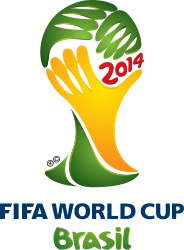 Juntos num só ritmo (lit. 'Together in a single rhythm') | |
| Tournament details | |
| Host country | Brazil |
| Dates | 12 June – 13 July |
| Teams | 32 (from 5 confederations) |
| Venue(s) | 12 (in 12 host cities) |
| Final positions | |
| Champions | |
| Runners-up | |
| Third place | |
| Fourth place | |
| Tournament statistics | |
| Matches played | 64 |
| Goals scored | 171 (2.67 per match) |
| Attendance | 3,429,873 (53,592 per match) |
| Top scorer(s) | (6 goals)[1] |
| Best player(s) | |
| Best young player | |
| Best goalkeeper | |
| Fair play award | |
← 2010 2018 → | |
The 2014 FIFA World Cup was the 20th FIFA World Cup, the quadrennial world championship for men's national football teams organised by FIFA. It took place in Brazil from 12 June to 13 July 2014, after the country was awarded the hosting rights in 2007. It was the second time that Brazil staged the competition, the first being in 1950, and the fifth time that it was held in South America.
31 national teams advanced through qualification competitions to join the host nation in the final tournament (with Bosnia and Herzegovina as the only debutant). A total of 64 matches were played in 12 venues located in as many host cities across Brazil. For the first time at a World Cup finals, match officials used goal-line technology, as well as vanishing spray for free kicks.[6] FIFA Fan Fests in each host city gathered a total of 5 million people, and the country received 1 million visitors from 202 countries.[7] Spain, the defending champions, were eliminated at the group stage. Host nation Brazil, who had won the 2013 FIFA Confederations Cup, lost to Germany 7–1 in the semi-finals and eventually finished in fourth place.[8]
In the final, Germany defeated Argentina 1–0 after extra time thanks to a Mario Götze half-volley in the 113th minute of the final[9] to win the tournament and secure the country's fourth world title, their first major tournament win since UEFA Euro 1996, the first after German reunification in 1990, when as West Germany they also beat Argentina by the same score in 90 minutes in the World Cup final. Germany became the first European team to win a World Cup staged in the Americas,[10] and this result marked the third consecutive title won by a European team, after Italy in 2006 and Spain in 2010.[11][12]
Host selection
[edit]
In March 2003, FIFA announced that the tournament would be held in South America for the first time since 1978, in line with its policy at the time of rotating the right to host the World Cup among different confederations.[13][14] With the 2010 FIFA World Cup hosted in South Africa, it would be the second consecutive World Cup outside Europe, which was a first for the tournament. It was also sixth time (second consecutive) in the Southern Hemisphere.[15] Only Brazil and Colombia formally declared their candidacy but, after the withdrawal of the latter from the process,[16] Brazil was officially elected as host nation unopposed on 30 October 2007.[17]
Participating teams and officials
[edit]Qualification
[edit]Following qualification matches played between June 2011 and November 2013, the following 32 teams – shown with their last pre-tournament FIFA world ranking[18] – qualified for the final tournament. Twenty-four of these teams were returning participants from the 2010 World Cup. Bosnia and Herzegovina were the only team with no previous appearance at the World Cup finals.[nb 1][19] Colombia qualified for the World Cup after 16 years of absence, while Belgium and Russia both returned after 12 years. Paraguay failed to qualify for the first time since 1994. This was also the first World Cup for 32 years that did not feature a representative from the Nordic countries. Iran, Costa Rica, Ecuador, and Croatia returned to the tournament after missing the 2010 tournament. The highest ranked team not to qualify was Ukraine (ranked 16th), while the lowest ranked team that did qualify was Australia (ranked 62nd).[18]
|
|
|
|
| Teams listed by FIFA ranking as of June 2014[18] | |||
|---|---|---|---|
| Country | Confederation | Rank | |
| 1 | UEFA | 1 | |
| 2 | UEFA | 2 | |
| 3 | CONMEBOL | 3 | |
| 4 | UEFA | 4 | |
| 5 | CONMEBOL | 5 | |
| 6 | UEFA | 6 | |
| 7 | CONMEBOL | 7 | |
| 8 | CONMEBOL | 8 | |
| 9 | UEFA | 9 | |
| 10 | UEFA | 10 | |
| 11 | UEFA | 11 | |
| 12 | UEFA | 12 | |
| 13 | CONCACAF | 13 | |
| 14 | CONMEBOL | 14 | |
| 15 | UEFA | 15 | |
| 16 | UEFA | 17 | |
| 17 | UEFA | 18 | |
| 18 | UEFA | 19 | |
| 19 | CONCACAF | 20 | |
| 20 | UEFA | 21 | |
| 21 | CAF | 22 | |
| 22 | CAF | 23 | |
| 23 | CONMEBOL | 26 | |
| 24 | CONCACAF | 28 | |
| 25 | CONCACAF | 33 | |
| 26 | CAF | 37 | |
| 27 | AFC | 43 | |
| 28 | CAF | 44 | |
| 29 | AFC | 46 | |
| 30 | CAF | 56 | |
| 31 | AFC | 57 | |
| 32 | AFC | 62 | |
As of 2022, this was the last time Chile, Ivory Coast, Greece, Italy, Honduras, and Algeria qualified for the World Cup finals, and the only time Bosnia and Herzegovina have qualified, and the last time Saudi Arabia, Morocco, Tunisia, Senegal, Denmark, Poland, and Serbia failed to qualify. This was also the most recent World Cup finals to feature every prior winning team.
Final draw
[edit]The 32 participating teams were drawn into eight groups. In preparation for this, the teams were organised into four pots with the seven highest-ranked teams joining host nation Brazil in the seeded pot.[20] As with the previous tournaments, FIFA aimed to create groups which maximised geographic separation and therefore the unseeded teams were arranged into pots based on geographic considerations.[21][22] The draw took place on 6 December 2013 at the Costa do Sauípe resort in Bahia, during which the teams were drawn by various past World Cup-winning players.[23][24] Under the draw procedure, one randomly drawn team – Italy – was firstly relocated from Pot 4 to Pot 2 to create four equal pots of eight teams.[25]
Officials
[edit]In March 2013, FIFA published a list of 52 prospective referees, each paired, on the basis of nationality, with two assistant referees, from all six football confederations for the tournament. On 14 January 2014, the FIFA Referees Committee appointed 25 referee trios and eight support duos representing 43 countries for the tournament.[26][27] Yuichi Nishimura from Japan acted as referee in the opening match whereas Nicola Rizzoli from Italy acted as referee in the final.[28][29]
| List of officials | ||||
|---|---|---|---|---|
| Confederation | Referee | Assistants | Support (referee/assist) | |
| AFC | Ravshan Irmatov (Uzbekistan) | Abdukhamidullo Rasulov (Uzbekistan) | Bakhadyr Kochkarov (Kyrgyzstan) | Alireza Faghani (Iran) / Hassan Kamranifar (Iran) |
| Yuichi Nishimura (Japan) | Toru Sagara (Japan) | Toshiyuki Nagi (Japan) | ||
| Nawaf Shukralla (Bahrain) | Yaser Tulefat (Bahrain) | Ebrahim Saleh (Bahrain) | ||
| Ben Williams (Australia) | Matthew Cream (Australia) | Hakan Anaz (Australia) | ||
| CAF | Noumandiez Doué (Ivory Coast) | Songuifolo Yeo (Ivory Coast) | Jean-Claude Birumushahu (Burundi) | Néant Alioum (Cameroon) / Djibril Camara (Senegal) |
| Bakary Gassama (Gambia) | Evarist Menkouande (Cameroon) | Félicien Kabanda (Rwanda) | ||
| Djamel Haimoudi (Algeria) | Redouane Achik (Morocco) | Abdelhak Etchiali (Algeria) | ||
| CONCACAF | Joel Aguilar (El Salvador) | William Torres (El Salvador) | Juan Zumba (El Salvador) | Roberto Moreno (Panama) / Eric Boria (United States) Walter López (Guatemala) / Leonel Leal (Costa Rica) |
| Mark Geiger (United States) | Mark Hurd (United States) | Joe Fletcher (Canada) | ||
| Marco Rodríguez (Mexico) | Marvin Torrentera (Mexico) | Marcos Quintero (Mexico) | ||
| CONMEBOL | Néstor Pitana (Argentina) | Hernán Maidana (Argentina) | Juan Pablo Belatti (Argentina) | Víctor Hugo Carrillo (Peru) / Rodney Aquino (Paraguay) |
| Sandro Ricci (Brazil) | Emerson De Carvalho (Brazil) | Marcelo Van Gasse (Brazil) | ||
| Enrique Osses (Chile) | Carlos Astroza (Chile) | Sergio Román (Chile) | ||
| Wilmar Roldán (Colombia) | Humberto Clavijo (Colombia) | Eduardo Díaz (Colombia) | ||
| Carlos Vera (Ecuador) | Christian Lescano (Ecuador) | Byron Romero (Ecuador) | ||
| OFC | Peter O'Leary (New Zealand) | Jan Hendrik Hintz (New Zealand) | Mark Rule (New Zealand) | Norbert Hauata (Tahiti) / Aden Marwa (Kenya) |
| UEFA | Felix Brych (Germany) | Mark Borsch (Germany) | Stefan Lupp (Germany) | Svein Oddvar Moen (Norway) / Kim Haglund (Norway) |
| Cüneyt Çakır (Turkey) | Bahattin Duran (Turkey) | Tarık Ongun (Turkey) | ||
| Jonas Eriksson (Sweden) | Mathias Klasenius (Sweden) | Daniel Wärnmark (Sweden) | ||
| Björn Kuipers (Netherlands) | Sander van Roekel (Netherlands) | Erwin Zeinstra (Netherlands) | ||
| Milorad Mažić (Serbia) | Milovan Ristić (Serbia) | Dalibor Đurđević (Serbia) | ||
| Pedro Proença (Portugal) | Bertino Miranda (Portugal) | Tiago Trigo (Portugal) | ||
| Nicola Rizzoli (Italy) | Renato Faverani (Italy) | Andrea Stefani (Italy) | ||
| Carlos Velasco Carballo (Spain) | Roberto Alonso Fernández (Spain) | Juan Carlos Yuste Jiménez (Spain) | ||
| Howard Webb (England) | Michael Mullarkey (England) | Darren Cann (England) | ||
Squads
[edit]As with the 2010 tournament, each team's squad consisted of 23 players (three of whom must be goalkeepers). Each participating national association had to confirm their final 23-player squad no later than 10 days before the start of the tournament.[30] Teams were permitted to make late replacements in the event of serious injury, at any time up to 24 hours before their first game.[30] During a match, all remaining squad members not named in the starting team were available to be one of the three permitted substitutions (provided the player was not serving a suspension).[30]
Venues
[edit]12 venues (seven new and five renovated) in twelve cities were selected for the tournament. The venues covered all the main regions of Brazil and created more evenly distributed hosting than the 1950 finals in Brazil.[31] Consequently, the tournament required long-distance travel for teams.[32] During the World Cup, Brazilian cities were also home to the participating teams at 32 separate base camps,[33] as well as staging official fan fests where supporters could view the games.[34]
The most used stadiums were the Maracanã and Brasília, which hosted seven matches each. The least-used venues were in Cuiabá, Manaus, Natal, and Curitiba, which hosted four matches each; as the four smallest stadiums in use at the tournament, they did not host any knockout round matches.[35]
| Rio de Janeiro | Brasília | São Paulo | Fortaleza |
|---|---|---|---|
| Estádio do Maracanã | Estádio Nacional | Arena Corinthians (Arena de São Paulo) | Estádio Castelão |
| Capacity: 74,738[35][A] | Capacity: 69,432[35][B] | Capacity: 63,321[35][C] | Capacity: 60,348[35][D] |
 |  | 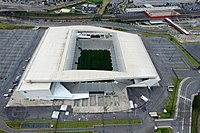 | 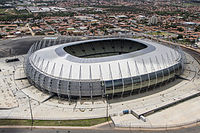 |
| Belo Horizonte | Salvador | ||
| Estádio Mineirão | Arena Fonte Nova | ||
| Capacity: 58,259[35][E] | Capacity: 51,708[35][F] | ||
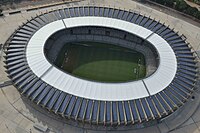 | 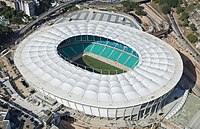 | ||
| Porto Alegre | Recife[nb 2] | ||
| Estádio Beira-Rio | Arena Pernambuco | ||
| Capacity: 43,394[35][G] | Capacity: 42,583[35][H] | ||
 |  | ||
| Cuiabá | Manaus | Natal | Curitiba |
| Arena Pantanal | Arena da Amazônia | Arena das Dunas | Arena da Baixada |
| Capacity: 41,112[35][I] | Capacity: 40,549[35][J] | Capacity: 39,971[35][K] | Capacity: 39,631[35][L] |
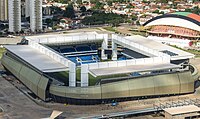 |  | 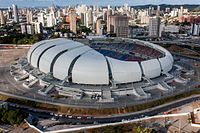 |  |
Team base camps
[edit]Base camps were used by the 32 national squads to stay and train before and during the World Cup tournament. On 31 January 2014, FIFA announced the base camps for each participating team,[33] having earlier circulated a brochure of 84 prospective locations.[36] Most teams opted to stay in the Southeast Region of Brazil, with only eight teams choosing other regions; five teams (Croatia, Germany, Ghana, Greece and Switzerland) opted to stay in the Northeast Region and three teams (Ecuador, South Korea and Spain) opted to stay in the South Region. None opted to stay in the North Region or the Central-West Region.[37] Campo Bahia, the base camp of the eventual champion Germany, attracted much interest.[38]
| National squads' base camps | |||||||||||||||||||||||||||||||||||||||||||||||||||||||||||||||||||||
|---|---|---|---|---|---|---|---|---|---|---|---|---|---|---|---|---|---|---|---|---|---|---|---|---|---|---|---|---|---|---|---|---|---|---|---|---|---|---|---|---|---|---|---|---|---|---|---|---|---|---|---|---|---|---|---|---|---|---|---|---|---|---|---|---|---|---|---|---|---|
|
| ||||||||||||||||||||||||||||||||||||||||||||||||||||||||||||||||||||
FIFA Fan Fests
[edit]
For a third consecutive World Cup tournament, FIFA staged FIFA Fan Fests in each of the 12 host cities throughout the competition. Prominent examples were the Copacabana Beach in Rio de Janeiro, which already held a Fan Fest in 2010, and São Paulo's Vale do Anhangabaú.[39][40] The first official event took place on Iracema Beach, in Fortaleza, on 8 June 2014.[41]
Innovations
[edit]Technologies
[edit]
In order to avoid ghost goals, the 2014 World Cup introduced goal-line technology following successful trials at, among other competitions, the 2013 Confederations Cup. The chosen Goal Control system featured 14 high speed cameras, 7 directed to each of the goals. Data were sent to the central image-processing centre, where a virtual representation of the ball was output on a widescreen to confirm the goal. The referee was equipped with a watch which vibrated and displayed a signal upon a goal.[42][43][44] France's second goal in their group game against Honduras was the first time goal-line technology was needed to confirm that a goal should be given.[45]
Following successful trials,[nb 3] FIFA approved the use of vanishing spray by the referees for the first time at a World Cup Finals. The water-based spray, which disappears within minutes of application, can be used to mark a ten-yard line for the defending team during a free kick and also to draw where the ball is to be placed for a free kick.[46]
The Adidas Brazuca was the official match ball of the 2014 FIFA World Cup[47][48][49][50] and was supplied by Forward Sports of Sialkot, Pakistan.[47] Adidas created a new design of ball after criticisms of the Adidas Jabulani used in the previous World Cup. The number of panels was reduced to six, with the panels being thermally bonded. This created a ball with increased consistency and aerodynamics compared to its predecessor. Furthermore, Adidas underwent an extensive testing process lasting more than two years to produce a ball that would meet the approval of football professionals.
Cooling breaks
[edit]Due to the relatively high ambient temperatures in Brazil, particularly at the northern venues, cooling breaks for the players were introduced.[51] Breaks could take place at the referee's discretion after the 30th minute of each half if the Wet Bulb Globe Temperature exceeded 32 °C (90 °F); the breaks would last 3 minutes, with this time made up by an extended period of stoppage time at the end of the half.
The first cooling break in a World Cup play took place during the 32nd minute of the match between the Netherlands and Mexico in the round of 16.[52][53][54][55] At the start of the match, FIFA listed the temperature at 32 °C (90 °F) with 68% humidity.[56]
Anti-doping
[edit]The biological passport was introduced in the FIFA World Cup starting in 2014. Blood and urine samples collected from all players before the competition, and from two players per team per match, were analysed by the Swiss Laboratory for Doping Analyses.[57] FIFA reported that 91.5% of the players taking part in the tournament were tested before the start of the competition and none tested positive.[58] However, FIFA was criticised for how it conducted doping tests.[59][60]
Format
[edit]The first round, or group stage, was a competition between the 32 teams divided among eight groups of four, where each group engaged in a round-robin tournament within itself. The two highest ranked teams in each group advanced to the knockout stage.[30] Teams were awarded three points for a win and one for a draw. When comparing teams in a group over-all result came before head-to-head.
| Tie-breaking criteria for group play |
|---|
The ranking of teams in each group was based on the following criteria:
|
In the knockout stage there were four rounds (round of 16, quarter-finals, semi-finals, and the final), with each eliminating the losers. The two semi-final losers competed in a third place play-off. For any match in the knockout stage, a draw after 90 minutes of regulation time was followed by two 15 minute periods of extra time to determine a winner. If the teams were still tied, a penalty shoot-out was held to determine a winner.[30]
The match schedule was announced on 20 October 2011[61] with the kick-off times being confirmed on 27 September 2012;[62] after the final draw, the kick-off times of seven matches were adjusted by FIFA.[63] The competition was organised so that teams that played each other in the group stage could not meet again during the knockout phase until the final (or the 3rd place match).[30] The group stage began on 12 June, with the host nation competing in the opening game as has been the format since the 2006 tournament. The opening game was preceded by an opening ceremony that began at 15:15 local time.[64]
Opening ceremony
[edit]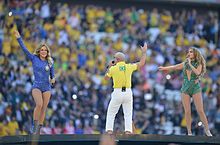
On 12 June 2014, the 20th edition of the FIFA World Cup began with the opening ceremony at Arena de São Paulo, São Paulo, Brazil. The event saw 660 dancers take to the stadium and perform in a ceremony which celebrated the nature of the country and its love of football. Following the dancers native singer Claudia Leitte emerged on centre stage to perform for the crowd. She was later joined by Cuban-American rapper Pitbull, and American singer Jennifer Lopez to perform the tournament's official song "We Are One (Ole Ola)" which had been released as an official single on 8 April 2014. Following the ceremony, the opening match was played, which saw the hosts come from behind to beat Croatia 3–1.[65][66][67]
Group stage
[edit]The group stage of the cup took place in Brazil from 12 June 2014 to 26 June 2014: each team played three games. The group stage was notable for a scarcity of draws and a large number of goals. The first drawn (and goalless) match did not occur until the 13th match of the tournament, between Iran and Nigeria: a drought longer than any World Cup since 1930.[68] The group stage produced a total of 136 goals (an average of 2.83 goals per match), nine fewer than were scored during the entire 2010 tournament.[69] This is the largest number of goals in the group stage since the 32-team system was implemented in 1998[70] and the largest average in a group stage since 1958.[71] World Cup holders Spain were eliminated after only two games, the quickest exit for the defending champions since Italy's from the 1950 tournament.[72] Spain also became the fourth nation to be eliminated in the first round while holding the World Cup crown, the first one being Italy in 1950 (and again in 2010), Brazil in 1966, and France in 2002.[73] For the first time, two teams from Africa advanced to the second round, a feat that would be repeated in the 2022 tournament.
Group A
[edit]
| Pos | Team | Pld | W | D | L | GF | GA | GD | Pts | Qualification |
|---|---|---|---|---|---|---|---|---|---|---|
| 1 | 3 | 2 | 1 | 0 | 7 | 2 | +5 | 7 | Advance to knockout stage | |
| 2 | 3 | 2 | 1 | 0 | 4 | 1 | +3 | 7 | ||
| 3 | 3 | 1 | 0 | 2 | 6 | 6 | 0 | 3 | ||
| 4 | 3 | 0 | 0 | 3 | 1 | 9 | −8 | 0 |
Group B
[edit]
| Pos | Team | Pld | W | D | L | GF | GA | GD | Pts | Qualification |
|---|---|---|---|---|---|---|---|---|---|---|
| 1 | 3 | 3 | 0 | 0 | 10 | 3 | +7 | 9 | Advance to knockout stage | |
| 2 | 3 | 2 | 0 | 1 | 5 | 3 | +2 | 6 | ||
| 3 | 3 | 1 | 0 | 2 | 4 | 7 | −3 | 3 | ||
| 4 | 3 | 0 | 0 | 3 | 3 | 9 | −6 | 0 |
| Spain | 1–5 | |
|---|---|---|
| Report |
|
| Australia | 2–3 | |
|---|---|---|
| Report |
|
Group C
[edit]
| Pos | Team | Pld | W | D | L | GF | GA | GD | Pts | Qualification |
|---|---|---|---|---|---|---|---|---|---|---|
| 1 | 3 | 3 | 0 | 0 | 9 | 2 | +7 | 9 | Advance to knockout stage | |
| 2 | 3 | 1 | 1 | 1 | 2 | 4 | −2 | 4 | ||
| 3 | 3 | 1 | 0 | 2 | 4 | 5 | −1 | 3 | ||
| 4 | 3 | 0 | 1 | 2 | 2 | 6 | −4 | 1 |
| Ivory Coast | 2–1 | |
|---|---|---|
| Report |
|
| Greece | 2–1 | |
|---|---|---|
| Report |
|
Group D
[edit]
| Pos | Team | Pld | W | D | L | GF | GA | GD | Pts | Qualification |
|---|---|---|---|---|---|---|---|---|---|---|
| 1 | 3 | 2 | 1 | 0 | 4 | 1 | +3 | 7 | Advance to knockout stage | |
| 2 | 3 | 2 | 0 | 1 | 4 | 4 | 0 | 6 | ||
| 3 | 3 | 1 | 0 | 2 | 2 | 3 | −1 | 3 | ||
| 4 | 3 | 0 | 1 | 2 | 2 | 4 | −2 | 1 |
| Italy | 0–1 | |
|---|---|---|
| Report |
|
Group E
[edit]
| Pos | Team | Pld | W | D | L | GF | GA | GD | Pts | Qualification |
|---|---|---|---|---|---|---|---|---|---|---|
| 1 | 3 | 2 | 1 | 0 | 8 | 2 | +6 | 7 | Advance to knockout stage | |
| 2 | 3 | 2 | 0 | 1 | 7 | 6 | +1 | 6 | ||
| 3 | 3 | 1 | 1 | 1 | 3 | 3 | 0 | 4 | ||
| 4 | 3 | 0 | 0 | 3 | 1 | 8 | −7 | 0 |
| Switzerland | 2–1 | |
|---|---|---|
| Report |
|
| Honduras | 0–3 | |
|---|---|---|
| Report |
|
Group F
[edit]
| Pos | Team | Pld | W | D | L | GF | GA | GD | Pts | Qualification |
|---|---|---|---|---|---|---|---|---|---|---|
| 1 | 3 | 3 | 0 | 0 | 6 | 3 | +3 | 9 | Advance to knockout stage | |
| 2 | 3 | 1 | 1 | 1 | 3 | 3 | 0 | 4 | ||
| 3 | 3 | 1 | 0 | 2 | 4 | 4 | 0 | 3 | ||
| 4 | 3 | 0 | 1 | 2 | 1 | 4 | −3 | 1 |
Group G
[edit]
| Pos | Team | Pld | W | D | L | GF | GA | GD | Pts | Qualification |
|---|---|---|---|---|---|---|---|---|---|---|
| 1 | 3 | 2 | 1 | 0 | 7 | 2 | +5 | 7 | Advance to knockout stage | |
| 2 | 3 | 1 | 1 | 1 | 4 | 4 | 0 | 4 | ||
| 3 | 3 | 1 | 1 | 1 | 4 | 7 | −3 | 4 | ||
| 4 | 3 | 0 | 1 | 2 | 4 | 6 | −2 | 1 |
Group H
[edit]
| Pos | Team | Pld | W | D | L | GF | GA | GD | Pts | Qualification |
|---|---|---|---|---|---|---|---|---|---|---|
| 1 | 3 | 3 | 0 | 0 | 4 | 1 | +3 | 9 | Advance to knockout stage | |
| 2 | 3 | 1 | 1 | 1 | 6 | 5 | +1 | 4 | ||
| 3 | 3 | 0 | 2 | 1 | 2 | 3 | −1 | 2 | ||
| 4 | 3 | 0 | 1 | 2 | 3 | 6 | −3 | 1 |
| Russia | 1–1 | |
|---|---|---|
| Report |
|


 French
French Deutsch
Deutsch
